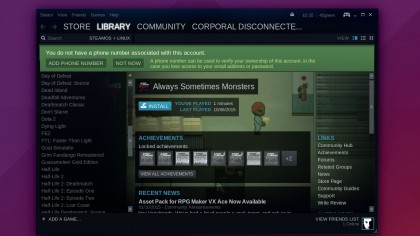How to get gaming on Linux
Don't waste money on Windows

Gaming on Linux has never been better. With over 1,500 games available on Steam alone that support Ubuntu (officially 12.04 LTS and many other distros, unofficially), the breadth of games that you can get on Linux is astonishing: from casual card games and puzzles for whiling away a few hours, to indie games that might be low on budget but are high on inventiveness, and even big budget 'AAA' games are now available.
Games are also beginning to run better than ever on Linux distros now that many game engines used by some of the biggest names in the gaming industry – such as the powerful CryEngine – have native Linux support.
Gamers switching from the more demanding Windows 10 OS to Linux can also see performance increases, as their system won't have to devote as much of its resources to background processes and instead concentrate on delivering the best gaming experience possible.
Good old games
Not only is there a plethora of choice when it comes to gaming on Linux, it's now easier than ever to get started. Although Valve's proprietary Steam store front has its issues – such as game DRM– it does make installing and running games an incredibly simple process.
It's also not the only game in the Linux-verse, Good Old Games is another service that sells games for Linux. It offers a mix of classic games (that have been made compatible with modern computers), new games and has a no-DRM policy.

Hardware manufacturers have also been upping their game as well, making good strides to ensure their graphics drivers are Linux compatible, so we can fit the most powerful gaming components into our machines.
Of course, the beauty of Linux is that if you're not too keen on using the hardware maker's proprietary drivers, there's a dedicated community creating third-party open source alternatives.
Sign up for breaking news, reviews, opinion, top tech deals, and more.
Thanks to the large variety of games available on Linux, the PC you use should be able to run at least some of them – though older machines without dedicated graphics cards may struggle to run the more graphically intensive and newer games – however you'll still be able to play some puzzle, indie and retro games.

If you want to give your PC a bit of a boost to handle more demanding games then you don't have to spend a fortune – a few modest upgrades here and there should give you a good experience when gaming.
Most games – unless they are huge open world games – aren't particularly CPU-intensive, so if you have semi-recent dual- or quad-core processor, then you'll most likely be fine to leave your CPU as it is.
Modern CPUs, such as Intel's Core i5 and Core i7 range, also include pretty decent integrated GPUs as well – which means you might not even need to buy a dedicated graphics card to play many games.
However, if your CPU is showing its age or you want to play more demanding games, then buying a dedicated graphics card is the best upgrade you can buy for your PC.
We have good news on two fronts here. First, most modern graphics cards play pretty nicely with Linux these days, so putting one in your system shouldn't cause any trouble. Both first-party and third-party drivers are quite easy to install too (more on that in a bit) and they generally behave themselves.
The second bit of good news is that you don't have to spend a lot of money to get a capable graphics card. Sure, there are some ludicrously expensive GPUs on the market, such as the Nvidia Titan X, but these are aimed at gaming enthusiasts.
For entry level and mid-range cards you can get something decent for between £60-£150 ($100-$200), depending on the level of performance that you require.
Despite these low prices you should be able to run most modern games smoothly thanks to most games being scalable for a variety of hardware configurations – so you might have to dial down an effect here or there, but you'll get smooth framerates.
Most modern games are also developed with the Xbox One and PlayStation 4 in mind, and despite being pretty new, these games consoles have relatively modest graphics capabilities compared to PCs.
If you want to future proof your gaming machine a general rule of thumb you can use when choosing a graphics card is that if you want to run games at resolutions higher than 1080p, or on more than one monitor, then we'd recommend going for a GPU with 4GB of GDDR memory.
However, for most casual gamers this will be overkill, and any card equipped with 2GB should be plenty.
With this in mind, we'd suggest a graphics card, such as the Nvidia GTX 950, is a great choice if you want to play most of the latest games at 1080p.
It comes with 2GB of memory and goes for around £130 ($200), which makes it excellent value for money. We got one in to test, in fact, and ran a number of benchmarks to see how well it performs.

Matt is TechRadar's Managing Editor for Core Tech, looking after computing and mobile technology. Having written for a number of publications such as PC Plus, PC Format, T3 and Linux Format, there's no aspect of technology that Matt isn't passionate about, especially computing and PC gaming. He’s personally reviewed and used most of the laptops in our best laptops guide - and since joining TechRadar in 2014, he's reviewed over 250 laptops and computing accessories personally.